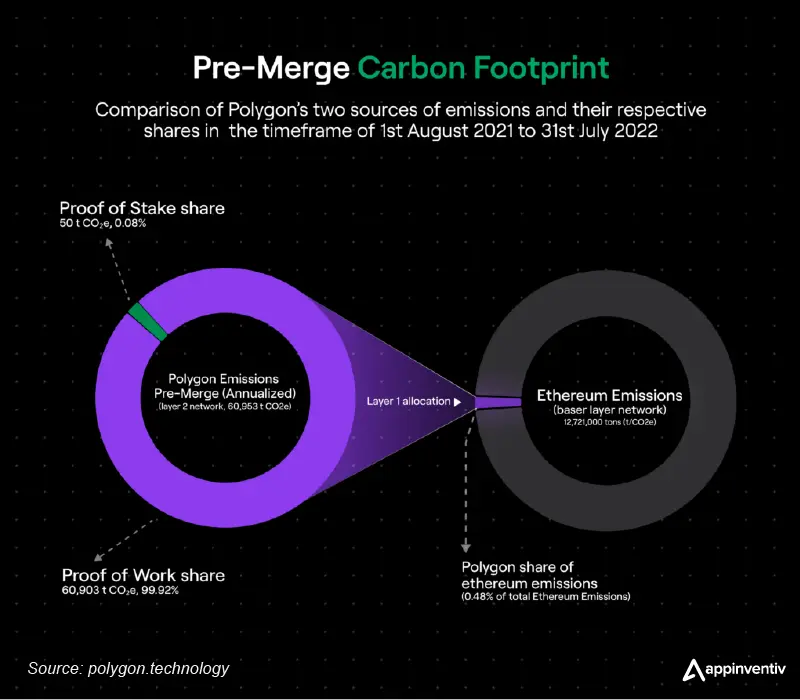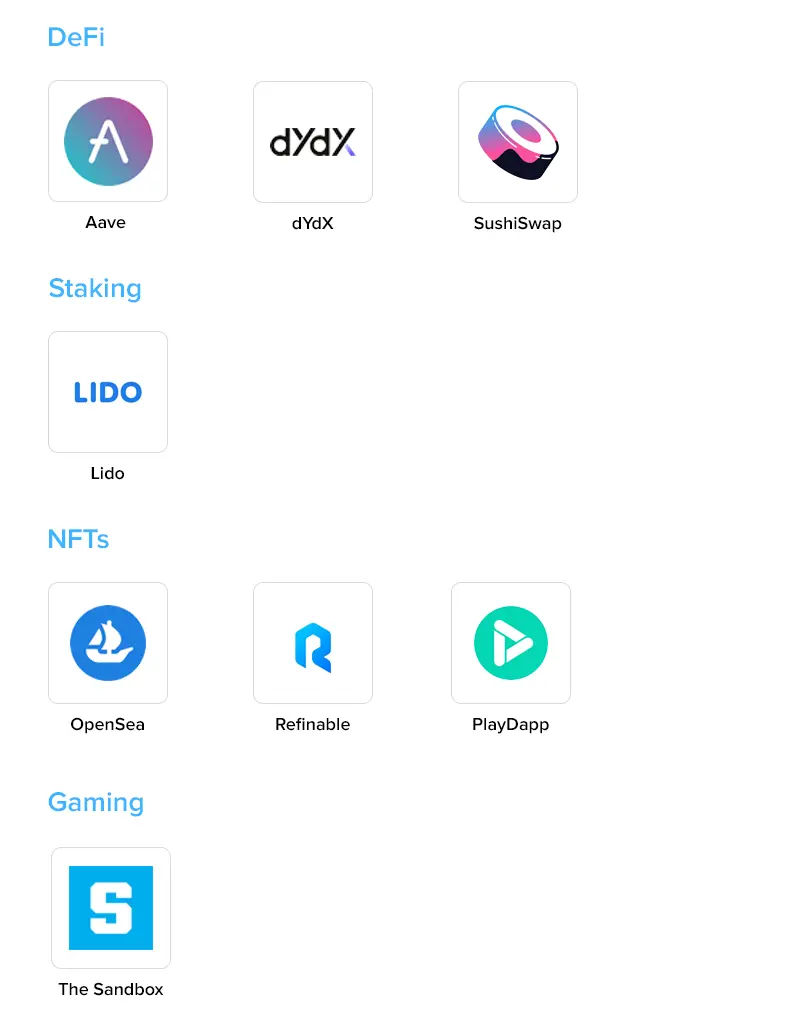Polygon aims to give people numerous choices when they create dApp on Polygon. Some developers keep security over speed while others compromise on security for lowered fees and speed – the technology is building multiple Ethereum-centric scaling solutions to address all these different features.
Ethereum has remained a pillar in the cryptocurrency space. Right from DeFi to smart contracts and even NFTs, Ethereum has remained one of the key innovations of Web3. However, inspite of the glaring success, the technology has struggled with massive network congestion, high network fees, and lowering transaction throughput – factors that have created a scope for newer crypto projects coming in to scale it. Polygon is one such project.
Originated in 2017, India-based software company Polygon Technology scales Ethereum without sacrificing on its decentralization benefits. With the number of dApps on Polygon having reached 53,000, businesses are using the technology’s low fees and fast speed to build Ethereum-powered dApps.
In this article, we are going to look into the different facets of Polygon and what makes the technology better than using Ethereum for dApps development.
How does the Polygon dApp builder work?
Polygon is a Layer 2 scaling solution that enables developers to build dApps on Ethereum without getting stuck with Ethereum’s limitations.
How it does that is by developing a layer 2 solution using off-chain on-chain concepts and different governance models like Proof of Stake, which helps the network lower its energy footprint by 99.95% – one which Etherum has also reached after The Merge. In addition to using a PoS architecture where the network participants stake MATIC for validating the transactions, Polygon enables developers to use its open source SDK to launch their Polygon dApp at the back of multiple scaling techniques:
ZK-Rollups: The ethereum-based technology acquired a zero-knowledge (ZK) protocol developer, Mir, for USD 400 million. What this protocol does is it enables transaction authenticators to validate the encrypted data without actually accessing the information enabling them to generate the verification proof in under 170 milliseconds.
Optimistic Rollups: It consists of bundling several off-chain transactions into massive batches before submitting them in Ethereum. This way, the fixed costs get spread across multiple transactions that reduce the end-user fees. In essence, this scaling technique assumes off-chain transactions validity without pushing out validity proofs for the on-chain transaction batches by following a fraud-proving methodology to identify transactions having discrepancies.
Plasma Chains: This scaling technique builds a child-parent relationship in Ethereum’s main chain. For example, the plasma chains can deploy their own dApps on Polygon which comes in handy when the other sidechains get hacked or are down. Additionally, the plasma chains tend to deliver off-chain transactions at higher efficiency levels.
At the back of these scaling methods, while the answer to how much time does it take to build dApp on Polygon is same as that on Ethereum or other blockchain technology, the transaction speed and cost difference is unmatched.
Features of Polygon for dApp development
The technology merges the capabilities of sovereign blockchains and Ethereum into an attractive feature set that helps developers build a decentralized app on Polygon that is highly efficient, scalable, and speedy.
Ethereum compatibility
When you build dApp on Polygon you work on a platform with complete Ethereum compatibility to tech stack, languages, standards, and tools.
High scalability
The technology is built on dedicated blockchains, a scalable consensus algorithm, and a customized Wasm execution environment.
Competitive network Greater security
Polygon dApp development is built on a modular “security as a service” facility offered either by Ethereum or a pool or validators.
Interoperability
The technology comes with a native support for the arbitrary messaging passing bridges for external systems and can easily connect with Ethereum main chain using the bridging SDKs polygon offers.
Good user experience
When you build dApp on Polygon it is very similar to one on Web2 purely at the back of a facility like instantaneous transaction finality.
Modularity
Polygon comes with high extensibility, customization, upgradability, community collaboration, and a short time-to-market.
These features of Polygon for dApp development are designed to bring the technology at par with the adoption of Ethereum minus all the limitations of the latter. This makes it profitable for developers and enterprises alike to build a decentralized app on Polygon.
Amidst these feature sets and the obvious benefits of Polygon for dApp development, is it time to let go of Ethereum? And on a technological level, what difference does Ethereum hold from Polygon dApp development?
Creating dApps on Polygon vs Ethereum
While The Merge moved Ethereum from proof-of-work to proof-of-stake, bringing down its 112 TWh of energy consumption down to 0.01 TWh, the technology is where Polygon already is.

The Merge however, didn’t change the high variable transaction cost that Ethereum comes with – a factor that Polygon addresses on a massive extent. In addition to this, the transaction processing speed has also remained unchanged, which in case of Polygon dApps development is only 65,000 transactions per second at the back of the Layer 2 scalability solution.
Let us look into the differences to understand why it makes sense to build dApps on Polygon.
| Factors | Ethereum | Polygon |
|---|---|---|
| Foundation | 2013 | 2017 |
| Scalability | 10 TPS | 7000 |
| Market Cap | 139.56 Billion | 7.698 Billion |
| Average transaction fees | 0.4876 | US$0.01 |
| Programming language | Solidity | Solidity, Golang, Vyper |
| Transaction Deterministic Finality | Instant | 5 minutes |
| Total dApps | 2970 | 53,000 |
While Polygon’s popularity is on a fast rise, there are some issues that are still prevalent in the technology. For understanding Polygon to its entirety, it is critical to know the limitations it comes attached with. Let us give a brief look at them:
- Ethereum Dependency: Ethereum lies at the center of Polygon’s ecosystem as its settlement layer. This has resulted in Polygon being completely dependent on Ethereum for its operations.
- Under Development: Presently, Polygon comes with Matic POS Chains and Matic Plasma as scaling solutions. Other scaling solutions such as Optimistic Rollups, zk Rollups, Sidechains, Validum Chains, and Enterprise Chains, etc. are still in their developmental stages with an unsurety around when they would be live.
- Matic Plasma Chains: Polygon plasma chains can only be used for a limited set of use cases. Comparatively, POS Chains are a lot more famous since they offer greater user experiences and flexibility when compared to Matic Plasma.
- Competition: There are a number of scaling solutions such as Solana, Cosmos, Polkadot, etc. which are gaining steady momentum. They are making use of Ethereum and other blockchains to offer better user experience. Amidst this, we might see other solutions coming up and taking Polygon’s market share.
With everything we have covered up until this point, one thing is clear – even though the technology has some limitations which need to be addressed, the benefits of Polygon for dApp development are unignorable. However, for an entrepreneur what is necessary is to know the use cases on which they can create dApp on Polygon.
The use cases to build dApp on Polygon
The biggest reason why dApp development service providers like Appinventiv choose Polygon is the fact that the end product is the same as what results from Ethereum app development but the customer experience is much greater. So while the businesses get the same Ethereum-powered app, their users get an innovative user experience, higher lowered transaction speed, and minimal transaction fees.
Payments: Polygon platform is engineered to create dApps that speed up the payment process, powering almost real-time payment settlement via specialized API and SDK integration. This enables apps, users, and merchants to instantly perform transactions through multiple cryptocurrencies, usually through the ETH or ERC-20 tokens. This system is being rolled out in three distinct phases: 1. ERC-20 token payments 2. Token transfer in cross-chain 3. Fiat-based payment models.
Lending Platform: The next use case to consider when you build dApp on Polygon is creating a module that would enable lenders to analyze users credit ratings and building a smart contract that would automate the loan disbursement journey.
Games: The Layer 2 sidechain scaling solution of Polygon makes blockchain-based gaming platform development efficient and fast. With Ethereum and Polygon working together, the platform will be able to address the lag issues that non-Polygon blockchain games face.
Other Use Cases: There are a range of other use cases to consider when you build a decentralized app on Polygon such as enabling fast settlement times required for decentralized exchanges to provide faster and cheaper trading.
[Also Read: How to monetize with your dApp?]
Amidst these use cases, the Polygon ecosystem is fast expanding. Here’s a look into some of the top applications that are a part of the network

Additionally, most of the dApps require a method to sign transactions without submitting in the users’ private keys details. On the back of its scalability enhancements, the technology helps in enabling an open identity framework for the dApp, thus solving the privacy issue.
These use cases are only a surface-level explanation of why businesses should develop dApp on Polygon. There are a range of other applications that can be built on Polygon.
Ultimately, even though Polygon dApps are built upon Ethereum, there are some very critical differences between them, specifically in transaction speed and cost. Such costly gas fees and slow transactions can lead to poor user experience that would leave a negative impact on the platform’s adoption. On this note, it makes better business sense to select Polygon, thanks to its ability to back faster transactions and lowered gas fees.
At Appinventiv, it is our constant endeavor to think about our clients’ customers first and this is the reason why we make dApp on Polygon. Using the technology we have built a range of decentralized apps right from a crypto wallet app to a DeFi exchange all promising a positive customer experience.
Looking to explore the technology for your next dApp project? Get in touch with our blockchain experts.



How to build a DeFi yield farming app?
Over time, blockchain, especially the crypto space, has been creating a bridge between traditional financial models with its own decentralized versions. Right from using cryptocurrencies to making payments to having DeFi and decentralized exchange platforms to enable trading, the crypto domain is closing the gap with the traditional financial ecosystem at a lightning speed. The…

How to build a DeFi staking platform?
Every investment related research you do irrespective of whether it is in stocks, mutual funds, or even gold, you will likely come across one common advice - profit lies in holding the investment. Now with 1 out 10 investors putting their money in cryptocurrency, the old adage around holding assets for long-term is getting extended…








